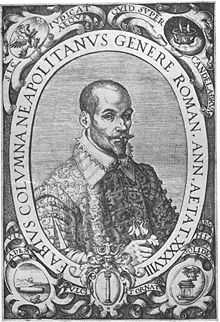Fabio Colonna
| Fabio Colonna | |
|---|---|
 Fabio Colonna | |
| Born |
1567 Napoli, Italy |
| Died |
25 July 1640 (aged 73) Napoli, Italy |
| Nationality | Italian |
| Fields | Naturalist and Botanist |
Fabio Colonna (1567 – 25 July 1640) was an Italian naturalist and botanist.
Biography
He was the son of Girolamo Colonna, a philologist and antique dealer who was also editor of the fragments of the Latin poet Ennius. As a youngster he became proficient in Latin and Greek before attending the University of Naples, where he graduated in law in 1589. He suffered from epilepsy, which prevented him from practicing law, so he turned to studying the ancient authors of medicine, botany and natural history.
In the period between 1606 and 1616, Fabio Colonna studied fossils, finding evidence for their organic origins.
The publication of his first works on botany, such as De purpura made him a celebrity among naturalists and one of the first members of the Accademia dei Lincei in Naples, which had been founded by Federico Cesi in 1612. In the following years, his academic activity at the Lincei was intense, including the writing of the Apiario and the Tesoro Messicano that the Lincei published in 1625 and 1628.
Colonna became interested in the recently invented telescope and microscope, corresponding with Galileo Galilei and other Lincean academics on astronomy.[1]
In 1625 he published two drawings, Apiarium and Melissographia, regarding bees.
Colonna was also interested in music, inventing a stringed, meantone temperament instrument, the pentecontachordon, having 50 strings in which the octave is divided into 17 parts and the tone into 3 parts.
Colonna was a pupil of Ferrante Imperato and a friend of Giambattista della Porta.
Selected works
- Phytobasanos ("Torture of plants"), Naples, 1592.[2]
- Ekphrasis altera, Rome, 1616. It contains 156 drawings by Colonna himself as well as two appendices: De Purpura and De glossopetris dissertatio, where Colonna makes an argument in favor of the organic origin of the glossopetrae.
- La sambuca lincea, ovvero dell'istromento musico perfetto, Naples, 1618, describing the construction of the pentecontachordon.
Source
This text is partially or fully derived from the project Mille anni di scienza in Italia and edited by the Istituto Museo di Storia della Scienza di Firenze. It is released under the Creative Commons License CC-BY-3.0.
Further reading
- "Janus Plancus" (Giovanni Bianchi[3]). "Fabii Columnae Lincei Vita". In: Phytobasanos, 1744, p. I–X (Latin)
Notes and references
- ↑ Fabio Colonna – Accademia dei Lincei
- ↑ Phytobasanos sive plantarum aliquot historia in qua describuntur diversi generis plantæ veriores, ac magis facie, viribúsque respondentes antiquorum Theophrasti, Dioscoridis, Plinii, Galeni, aliquorúmque delineationibus, ab alijs hucusque (sic) non animaduersæ
- ↑ The identification of Janus Plancus with Giovanni Bianchi is based on that made by worldcat.org.
See also
- Giovan Battista della Porta
External links
- Università di Palermo. "Fabio Colonna (1567–1640)". math.unipa.it. Università degli Studi di Palermo.
- Online Galleries, History of Science Collections, University of Oklahoma Libraries High resolution images of works by and/or portraits of Fabio Colonna